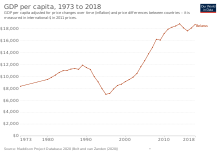
Back اقتصاد روسيا البيضاء Arabic Economía de Bielorrusia AST Belarus iqtisadiyyatı Azerbaijani Эканоміка Беларусі Byelorussian Эканоміка Беларусі BE-X-OLD Economia de Belarús Catalan Ekonomika Běloruska Czech Wirtschaft von Belarus German Οικονομία της Λευκορωσίας Greek Economía de Bielorrusia Spanish
 Minsk, the financial capital of Belarus | |
| Currency | Belarusian ruble (BYN, Rbl) |
|---|---|
| Calendar year | |
Trade organisations | CIS, EAEU, CISFTA |
Country group |
|
| Statistics | |
| Population | |
| GDP | |
| GDP rank | |
GDP growth |
|
GDP per capita | |
GDP per capita rank | |
GDP by sector |
|
GDP by component |
|
| 4.8% (2020 est.)[4] | |
Population below poverty line | |
Labour force | |
Labour force by occupation |
|
| Unemployment | |
Average gross salary | Br 2,026 (€578) (2024-02)[15] |
| Br 1,745 (€498) (2024-02)[15] | |
Main industries | metal-cutting machine tools, tractors, trucks, earthmovers, motorcycles, synthetic fibers, fertilizer, textiles, refrigerators, washing-machines and other household appliances Agricultural products: grain, potatoes, vegetables, sugar beets, flax; beef, milk |
| External | |
| Exports | |
Export goods |
|
Main export partners | |
| Imports | |
Import goods |
|
Main import partners | |
FDI stock | |
Gross external debt | |
| Public finances | |
| +2.9% (of GDP) (2017 est.)[6] | |
| Revenues | 22.15 billion (2017 est.)[6] |
| Expenses | 20.57 billion (2017 est.)[6] |
| |

The economy of Belarus is an upper-middle income mixed economy.[2] As a post-Soviet transition economy, Belarus rejected most privatisation efforts in favour of retaining centralised political and economic controls by the state.[20] The highly centralized Belarusian economy emphasizes full employment and a dominant public sector. It has been described as a welfare state[21] or market socialist.[22] Belarus is the world's 74th-largest economy by GDP.
As of 2018[update], Belarus ranks 53rd from 189 countries on the United Nations Human Development Index, and appeared in the group of states with "very high development". With an efficient health system, it has a very low infant-mortality rate of 2.9 (compared to 6.6 in Russia or 3.7 in the United Kingdom). The rate of doctors per capita is 40.7 per 10,000 inhabitants (the figure is 26.7 in Romania, 32 in Finland, 41.9 in Sweden) and the literacy rate is estimated[by whom?] at 99%. According to the United Nations Development Program, the Gini coefficient (inequality indicator) is one of the lowest (best) in Europe.[23]
- ^ "World Economic Outlook Database, April 2019". IMF.org. International Monetary Fund. Retrieved 29 September 2019.
- ^ a b "World Bank Country and Lending Groups". datahelpdesk.worldbank.org. World Bank. Retrieved 29 September 2019.
- ^ "Population on 1 January". ec.europa.eu/eurostat. Eurostat. Retrieved 13 July 2020.
- ^ a b c d e "World Economic Outlook Database, October 2022". IMF.org. International Monetary Fund. October 2022. Retrieved October 11, 2022.
- ^ Global Economic Prospects, June 2020. World Bank. 8 June 2020. p. 80. doi:10.1596/978-1-4648-1553-9. ISBN 978-1-4648-1553-9. S2CID 225749731. Retrieved 10 June 2020.
- ^ a b c d e f g h i j k l m n "EUROPE :: BELARUS". CIA.gov. Central Intelligence Agency. Retrieved 15 January 2020.
- ^ "Poverty headcount ratio at national poverty lines (% of population) - Belarus". data.worldbank.org. World Bank. Retrieved 15 January 2020.
- ^ Europe Central Asia Economic Update, Spring 2020: Fighting COVID-19. World Bank. 9 April 2020. pp. 43, 44. ISBN 978-1-4648-1564-5. Retrieved 9 April 2020.
- ^ "WorldBank, 2017". worldbank.org. World Bank Group. Retrieved 20 March 2020.
- ^ "Human Development Index (HDI)". hdr.undp.org. HDRO (Human Development Report Office) United Nations Development Programme. Retrieved 12 October 2022.
- ^ "Inequality-adjusted HDI (IHDI)". hdr.undp.org. UNDP. Retrieved 12 October 2022.
- ^ "Labor force, total - Belarus". data.worldbank.org. World Bank. Retrieved 8 January 2020.
- ^ "Employment to population ratio, 15+, total (%) (national estimate) - Belarus". data.worldbank.org. World Bank. Retrieved 8 January 2020.
- ^ "Labour force participation rate". belstat.gov.by. National Statistical Committee of the Republic of Belarus. Retrieved 8 January 2020.
- ^ a b "News". www.myfin.by.
- ^ a b "Belarus - WTO Statistics Database". World Trade Organization. Retrieved 24 March 2019.
- ^ "Export partners of Belarus". The Observatory of Economic Complexity. Retrieved 14 April 2023.
- ^ "İmport partners of Belarus". The Observatory of Economic Complexity. Retrieved 14 April 2023.
- ^ "Sovereigns rating list". Standard & Poor's. Retrieved 26 May 2011.
- ^ Viachaslau Yarashevich (2014). "Political Economy of Modern Belarus: Going Against Mainstream?". Europe-Asia Studies. 66 (10): 1703–1734. doi:10.1080/09668136.2014.967571. S2CID 153993706.
- ^ E.Sh. Veselova (2016). "The Market-Socialist Country". Problems of Economic Transition. 58 (6): 546–555. doi:10.1080/10611991.2016.1222209. S2CID 157129993.
- ^ Li, Yan; Cheng, Enfu (2020-12-01). "Market Socialism in Belarus: An Alternative to China's Socialist Market Economy". World Review of Political Economy. 11 (4): 428–454. doi:10.13169/worlrevipoliecon.11.4.0428. ISSN 2042-8928. S2CID 236786906.
- ^ Le Bélarus, l'Etat miraculé. (28 April 2019) - "Sur le plan des inégalités, selon le Programme des Nations unies pour le développement, le coefficient de Gini (qui est un indicateur de la répartition des revenus, 0 étant l'égalité parfaite et 1 ou 100 étant l'inégalité la plus extrême) du Bélarus est l'un des plus bas du continent : 27 (Alors qu'il est de 37,2 en Estonie, 34 en Italie, 31,8 en Pologne et 23,2 en Slovaquie... mais 25,6 en Islande)."
© MMXXIII Rich X Search. We shall prevail. All rights reserved. Rich X Search